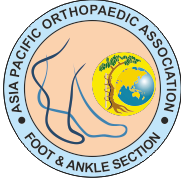Virtual Fellowship 2025
Comprehensive course. Please whittle this down. Bear in mind that AVN of the talus is a key underlying pathology in ankle replacement
Mueller-Weiss Syndrome
Table of contents
1. Syllabus: Mueller-Weiss Syndrome (MWS) 🦶 [edit]
2. Session 1: Foundation and Pathophysiology [edit]
3. Session 2: Clinical Presentation and Staging [edit]
4. Session 3: Diagnostic Imaging [edit]
A detailed syllabus for discussing Mueller-Weiss Syndrome (MWS) is provided below. This syllabus is designed for medical students, residents, or allied healthcare professionals, offering a structured approach to understanding the condition, its presentation, diagnosis, and management.
Syllabus: Mueller-Weiss Syndrome (MWS) 🦶 [edit]
| Course Level: | Advanced Undergraduate/Post-Graduate Medical/Allied Health |
| Duration: | 4 Sessions (Approx. 6-8 hours total) |
| Target Audience: | Orthopedic Residents, Podiatrists, Physiotherapists, Radiologists, Medical Students |
| Prerequisites: | Basic knowledge of lower limb anatomy, biomechanics, and musculoskeletal pathology. |
| Course Goal: | To enable participants to accurately diagnose and formulate a comprehensive management plan for patients with Mueller-Weiss Syndrome. |
Session 1: Foundation and Pathophysiology [edit]
| Topic | Key Concepts & Learning Objectives | Activities & Resources |
| 1.1 Introduction to MWS | Define Mueller-Weiss Syndrome (MWS), synonyms (e.g., Spontaneous Aseptic Necrosis of the Navicular), and its historical context. | Lecture, Review of classic literature (e.g., Mueller's original descriptions). |
| 1.2 Epidemiology & Etiology | Discuss the prevalence, typical age of onset, and gender predilection. Examine the controversial etiologies: biomechanical overload, congenital factors (e.g., abnormal navicular morphology), vascular compromise, and trauma. | Group discussion on pathogenic theories, Review of epidemiological studies. |
| 1.3 Normal Foot Biomechanics | Review the normal anatomy of the midfoot, focusing on the navicular bone and its role in the medial column. Discuss the forces and stresses on the navicular during gait. | Anatomy review session, Video analysis of normal gait. |
| 1.4 Pathophysiology of Necrosis | Detail the proposed mechanism of avascular necrosis (AVN) in the navicular. Explain the progression from compression and ischaemia to fragmentation and collapse (dorsal migration). | Diagramming the progression of MWS, Review of histological findings (if available). |
Session 2: Clinical Presentation and Staging [edit]
| Topic | Key Concepts & Learning Objectives | Activities & Resources |
| 2.1 Clinical Features | Identify the classic signs and symptoms: insidious onset of chronic, vague midfoot pain (dorsomedial aspect), often worse with weight-bearing and activity. Recognize compensatory gait changes. | Case presentations, Clinical examination demonstration (e.g., palpation, range of motion). |
| 2.2 Physical Examination | Outline the essential components of a midfoot exam: inspection (e.g., arch collapse, swelling), palpation (e.g., tenderness over the navicular/talonavicular joint), and assessment of hindfoot alignment(e.g., varus/valgus). | Practicum: Peer-to-peer examination, Checklist for MWS-focused physical exam. |
| 2.3 Differential Diagnosis | Differentiate MWS from common causes of midfoot pain: Kohler's disease (pediatric AVN of the navicular), tarsal coalition, stress fracture, posterior tibial tendon dysfunction (PTTD), and osteoarthritis. | Table comparison of MWS vs. PTTD vs. Kohler's, Clinical vignettes. |
| 2.4 Classification Systems | Understand and apply the Classification of MWS (e.g., Maceira and Rocher classification) based on the degree of navicular collapse, fragmentation, and lateral subluxation. | Review of radiographic examples for each stage, Discussion of prognostic implications of staging. |
Session 3: Diagnostic Imaging [edit]
| Topic | Key Concepts & Learning Objectives | Activities & Resources |
| 3.1 Standard Radiography | Specify the necessary radiographic views (weight-bearing AP, lateral, and oblique) and the key signs: comma-shaped navicular, lateral compression, fragmentation, and medial subluxation of the talus/lateral shift of the forefoot. | Radiographic image bank review, Focus on measuring navicular position and arch integrity. |
| 3.2 Advanced Imaging: CT Scan | Explain the role of Computed Tomography (CT) in defining the extent of navicular destruction, assessing fragmentation, and evaluating adjacent joint involvement (talonavicular and naviculocuneiform). | CT cross-sectional anatomy and pathology review, Correlation with surgical planning. |
| 3.3 Advanced Imaging: MRI | Describe the Magnetic Resonance Imaging (MRI) findings: low signal intensity on T1-weighted images and variable intensity on T2/STIR (reflecting edema, necrosis, or sclerosis). Discuss its utility in early diagnosis and differentiating from other conditions. | Review of characteristic MRI sequences, Discussion on the sensitivity of MRI in detecting AVN. |
| 3.4 Imaging Pitfalls | Identify common errors in diagnosis and interpretation of imaging, and when to suspect other pathologies. | Quiz on challenging diagnostic images, Peer review of cases. |
Session 4: Management and Treatment [edit]
| Topic | Key Concepts & Learning Objectives | Activities & Resources |
| 4.1 Non-Operative Management | Detail conservative treatment options: rest, NSAIDs, orthotics (custom arch supports), bracing, and physical therapy. Identify the stages where non-operative care is most appropriate (early stage/mild symptoms). | Review of evidence for conservative therapies, Practical demonstration of custom orthotic principles. |
| 4.2 Indications for Surgery | Establish clear criteria for progressing to surgical intervention (e.g., failure of conservative treatment, advanced stage disease, severe pain/deformity). | Case-based discussion on surgical decision-making. |
| 4.3 Surgical Techniques | Discuss the range of surgical procedures: isolated arthrodesis(talonavicular, naviculocuneiform), double arthrodesis (TNC fusion), and triple arthrodesis. Compare techniques for navicular reconstruction and bone grafting. | Review of surgical technique videos, Discussion on fixation principles and fusion rates. |
| 4.4 Post-Operative Care & Outcomes | Outline the typical rehabilitation protocol following arthrodesis. Discuss potential complications (e.g., non-union, transfer pain/arthritis) and long-term prognosis. Review patient-reported outcome measures. | Creating a post-operative timeline, Critical appraisal of surgical outcome studies. |
Recommended Reading & Resources [edit]
Key Textbooks: Relevant chapters on midfoot pathology and avascular necrosis in standard orthopedic/podiatric texts (e.g., Campbell's Operative Orthopaedics, Foot and Ankle Surgery).
Journal Articles: Seminal and contemporary articles on MWS diagnosis, classification, and surgical outcomes (e.g., Foot & Ankle International, The Journal of Bone and Joint Surgery).
Imaging Atlases: Atlases focused on musculoskeletal radiology, highlighting the classic radiographic and advanced imaging features of MWS.
Online Resources: Access to anatomical models, surgical video libraries, and relevant society guidelines (e.g., AOFAS).

